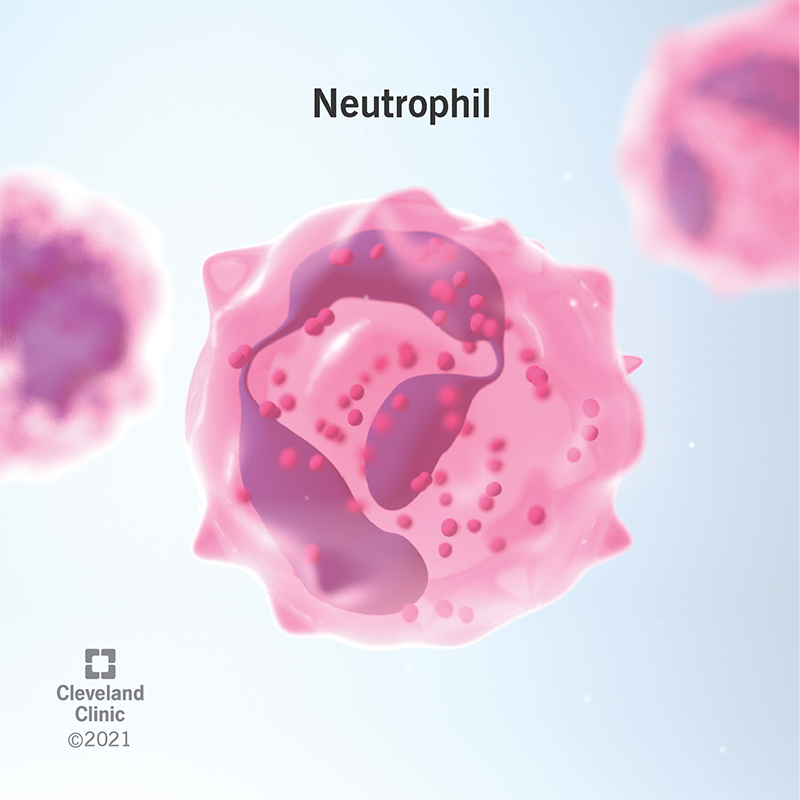Neutrophils help your immune system fight infections and heal injuries. Neutrophils are the most common type of white blood cell in your body. An absolute neutrophil count identifies whether your body has enough neutrophils or if your count is above or below a healthy range. Several conditions can cause high or low neutrophil counts.
Advertisement
Cleveland Clinic is a non-profit academic medical center. Advertising on our site helps support our mission. We do not endorse non-Cleveland Clinic products or services. Policy

Neutrophils are a crucial type of white blood cell (leukocyte). They serve as your body’s first line of defense against infections. Classified as granulocytes, neutrophils work alongside other white blood cells to protect against infection and injury.
Advertisement
Cleveland Clinic is a non-profit academic medical center. Advertising on our site helps support our mission. We do not endorse non-Cleveland Clinic products or services. Policy
Although white blood cells only make up 1% of your blood cells, you have more neutrophils than any other type. The high numbers mean that neutrophils play an especially significant role in keeping you healthy. Related, your neutrophil levels provide valuable insights about your health.
Your neutrophils are essential parts of your immune system. They actively combat infections.
Imagine your immune system as a general commanding your body’s defenses, preventing the entry of bacteria, viruses and fungi. White blood cells act as troops patrolling your bloodstream and tissues, identifying potential threats.
When an infection occurs, neutrophils are the first responders. They neutralize invading bacteria and microorganisms by trapping and ingesting them. Your body’s response to this immune activity includes redness and inflammation. While this is happening, your neutrophils start the process of repairing tissue.
Neutrophils form and develop in your bone marrow. Once they’ve matured, they travel throughout your body in your blood, tissues and lymph nodes.
Neutrophils are clear in color. When your healthcare provider examines your cells under a microscope, they add a dye that changes their color so they’re visible. Neutrophils have a spherical shape (like a marble) when at rest, but change shape to fight infection.
Advertisement
Neutrophils are the most common type of white blood cell. They make up over half (from 55% to 70%) of all white blood cells in your body. Neutrophils live for less than 24 hours, which means your body is constantly making new ones. The average healthy adult makes over 100 billion neutrophils a day.
The number of neutrophils in your body needs to remain in a specific range to keep your body functioning normally. High or low neutrophil counts can put you at risk of certain health conditions:
A blood test called an absolute neutrophil count identifies how many neutrophils are in a sample of your blood. The normal range of neutrophils in a healthy adult is between 2,500 and 7,000 neutrophils per microliter of blood. Any number above 7,000 or below 2,500 puts you at risk of a neutrophil condition.
Contact your healthcare provider if you notice changes in your body that may be related to high or low neutrophils. Signs and symptoms include:
They’ll examine you and do blood tests, like a complete blood count (CBC) and an absolute neutrophil count (ANC), to check your levels. Depending on your neutrophil count, you may need more tests to diagnose an underlying condition.
Neutrophils are your body’s first line of defense against infection or injury. Keep your army of cells healthy by maintaining good hygiene to prevent infections, treating any injury or infections that you might have and eating well-balanced, nutritious meals. Taking steps to keep from getting sick is good for your immune system and for your neutrophils, specifically.
Advertisement
Cleveland Clinic’s primary care providers offer lifelong medical care. From sinus infections and high blood pressure to preventive screening, we’re here for you.

Last reviewed on 03/21/2025.
Learn more about the Health Library and our editorial process.